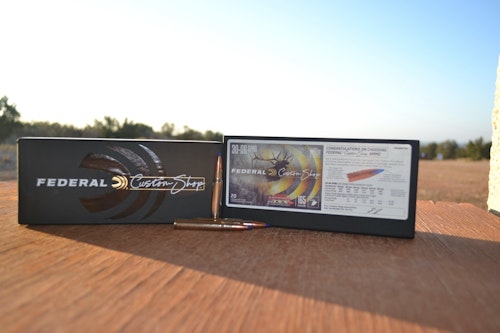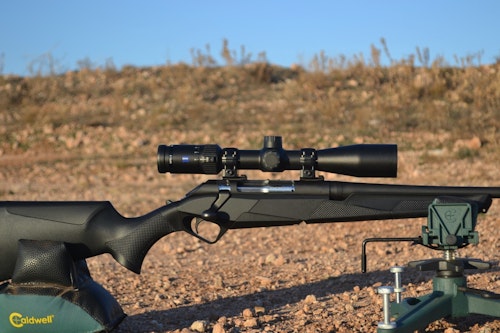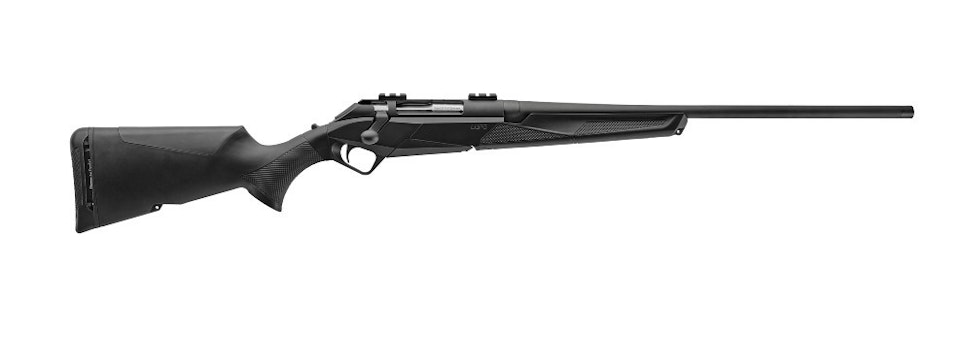You know Benelli as a shotgun manufacturer, famous for the Super Black Eagle, Nova, M2, Ethos and other classic models. But the company is branching out — in January 2020, it introduced the Lupo, its first bolt-action rifle.
FI handled the Lupo at the 2020 SHOT Show and was anxious for some hands-on, live fire experience with it. The chaos of 2020 delayed that for a few months, but I finally took the Lupo on a deer hunt in December and sat down for a long chat with George Thompson, Benelli USA’s director of product management, about the gun.
First, I asked the question you’re probably already thinking: After so many years successfully making shotguns, why a rifle, and why now? “Bolt-action rifles are the largest chunk of firearms that are sold,” Thompson told me. “Benelli wants to continue to grow; we already dominate in the shotgun space, so from a business perspective, rifles are the biggest opportunity for us and make the most sense. From a manufacturing perspective, with Benelli’s robotic manufacturing and ability to hold the tightest tolerances in firearms production, we knew we could make a very accurate rifle. We have some great innovations in our shotguns that could be applicable to rifles that would show some great benefits to the rifle shooter. It was the biggest market opportunity, and we felt like we had the manufacturing and expertise to make a damn fine rifle.”
Turns out, Benelli had been talking about making a bolt-action rifle for more than a decade. “Bolt-action rifles seemed to be an underserved market in that there hasn’t really been a lot of innovation there,” said Thompson, “and we thought we could bring some really exciting stuff to it. About six years ago, it became an official project, and we started working on it.” The Lupo was engineered and built in Urbino, Italy, as all Benelli products are, with the U.S. team contributing a wish list of desired features that would be a hit in the market. The project was actually finished in early 2019, but Benelli spent a year doing testing and evaluations before going to market.
One of the first things you’ll notice about the Lupo is that it looks like a Benelli. The angles and the shape are all reminiscent of the company’s other offerings. I asked Thompson if that was intentional. “Well, it looks like a Benelli, but even more than that, it looks like an Italian craftsman made it,” he said. “Art is embedded in their culture, so they always pay a ton of attention to the cosmetic lines and shape of the gun and all the exterior components. I think that’s why you see a lot of similarities. However, early on in this project we were very cognizant that the traditional bolt-action rifle hunter is conservative as to gun designs. He doesn’t want something that looks crazy, even if it’s amazing. If it looks too different, it may not appeal to that customer. So we tried to keep it as traditional-looking as we could, but at the same time, adding that Benelli flair and innovation into it.”
Accuracy
One of the key features is accuracy, but Thompson almost takes that for granted. “I kinda view accuracy as the cost of entry,” he said. “If you don’t make an accurate rifle, don’t even waste your time. So while our gun is extremely accurate, it kinda has to be. It’s important and we’re proud of it, but it doesn’t really set us apart by itself. What sets us apart is the recoil reduction and the customization of the gun to fit the shooter. These things combined allow somebody to get the most accuracy they can out of the rifle. You know, it’s one thing to have a rifle you can lock in a vise and it shoots accurately. It’s another thing to put it on your shoulder and you shoot it accurately. And we think we’ve bridged that gap with the Lupo.”
Indeed, the Lupo has a sub-MOA guarantee, and it continues to shoot well even when it gets hot.
“I believe the Crio treating probably has a heavy hand in that,” Thompson said. “They take the barrels and put them in a special freezer that takes them down to -300 degrees and then brings them back up to room temp, in a very controlled process that takes 24 hours or more. That relieves all the mechanical stress and machining stress that’s put into a barrel when it’s manufactured. At a microscopic level, it makes the barrel smoother, and that makes it last longer and makes it easier to clean.”
The Lupo’s threaded, Crio-treated, free-floating barrel is attached to a hardened steel barrel extension bedded to a steel block in the alloy receiver. It’s a solid, accurate platform by design.
Another part of what makes the Lupo so accurate is the trigger, which I found to be excellent. It’s clean and crisp, with no overtravel, and though it comes from the factory set around 3 pounds, it’s user-adjustable from 2.2 to 4.5 pounds to match your preference.

Features
One of the stand-out features of the Lupo is the level of adjustability it offers. Length of pull is easy to adjust, and included shims also allow the shooter to adjust drop and cast for a personalized fit. In total, the shims offer 36 different positions in combination with each other. Two raised cheek pads and a different length butt pad are available as optional extras for additional customization.
“You know how it goes,” said Thompson. “You take a rifle, close your eyes and mount it, and when you open your eyes, you can never see clearly through the scope. You always have to adjust it in some way. And I wanted to solve that. You can never shoot your best if you’re holding your head above the stock or you’re kicking it to one side so you can see clearly through the scope. I wanted to solve that problem, and that was one of the key things we targeted. Once we decided to make a chassis frame and break the buttstock off of it, we knew we could use our shim systems and have adjustability there. That’s exactly what we’ve done. The idea with the adjustability is that you can close your eyes, shoulder the gun, and when you open them, the crosshair is clean and you can see what you want to see.
“You don’t want to be thinking about the gun when you go to shoot a target or an animal. If the gun doesn’t fit you well, if you’re scared of recoil, if you don’t feel like it’s accurate, if the trigger is rough — all those things will distract from you accomplishing your goal. We wanted to remove all those things from the equation. We wanted to remove the gun from the equation at some level, so it has no bearing on whether or not you’re successful. You just focus on what you need to do and the gun will get the job done for you.”
Another major selling feature is the gun’s recoil system. Benelli claims 30 percent recoil reduction (compared to the same gun without a reduction system), which is admittedly hard to pin down, because everyone experiences felt recoil differently. After my range time with the gun, I feel confident saying the Lupo is the lightest-recoiling .30-06 I’ve ever fired, with a butter-smooth bolt to boot.
How is this achieved? Benelli took the Progressive Comfort recoil-reduction system it uses in its Ethos and 828 shotguns and modified it for use in a rifle. “You can’t see the ComfortTech system because it’s all hidden on the inside of the stock,” Thompson explained, “but there’s a cartridge, if you will, that’s about the size of a cassette tape, that slides inside the buttstock. Inside there, there’s a series of fingers that interlock, and they flex to absorb the recoil. It’s really kind of a simple, ingenious system, and it works really well. It’s called Progressive Comfort because it’s designed for a shotgun, and the fingers I mentioned have different levels of elasticity. The first fingers are very flexible, the second set a little stiffer, and the third set even more stiff. That’s because on a shotgun, you have different-powered shells that you might be shooting, from light 2 3/4-inch loads to heavy magnum loads, and the recoil curve is very different on all of those. We call it progressive because it flexes more or less depending on the shells you use. So the system reduces recoil by a similar percentage across the whole spectrum of ammunition. In a rifle, you don’t have as much variance as you do in shotguns, so the Progressive Comfort was modified for that. The number of fingers and the elasticity of those fingers were optimized for a centerfire, bolt-action rifle.”
Additional features include Benelli’s AirTouch checkering, ambidextrous safety, detachable box mag (five rounds), Combtech cheek pad, chromed bolt with three lugs and a 60-degree throw, and a two-piece Picatinny rail.
Overall, I found the gun comfortable to use and easy to shoot, with an excellent trigger and good ergonomics. Benelli’s attention to detail is clear, with a fine fit and finish. Everything from working the bolt to snicking the safety to seating the magazine is smooth and clean — no sticking or manhandling required. The gun definitely shoots sub-MOA on the range, with minimal recoil. Unfortunately, I did not get to test performance on live game, as the deer and pig hunting was tough sledding the week I was in Texas. At around 7 pounds, it’s not too heavy to carry around, but not so light as to affect recoil or accuracy.
After spending a few weeks with the Lupo, it became clear to me why the price point falls where it does. This gun is in a different class than the bargain-priced rifles in my safe and on your shelves. The combination of features and fit/finish add up to what feels like a custom rifle.
Selling The Lupo
Benelli sells through an authorized dealer network, so if you want to sell Benelli products, you’ll be going through the Benelli program, which Thompson says is easy and not overly burdensome regarding financial or inventory requirements.
There’s a little bit of an elephant in the room when you’re selling the Lupo to shoppers, and that’s price. The gun carries an MSRP around $1,700, which falls somewhere between a budget rifle and a custom one. Thompson acknowledges this: “From a sales person’s perspective, when you compare our rifle to other rifles on the market, we’re more expensive. The Benelli Lupo is going to retail between $1,500 and $1,700 depending on where you buy it, because dealers can sell it for whatever they want to. When you look at some of the competitor products out there, looking at some of the premium brands, we’re right around their price point, depending on what models you’re looking at. When you look at some of the other brands that sell popular rifles, we’re way more expensive.”
So what do you tell a shopper who’s comparing the Lupo to a $500 bolt-action rifle from one of the other major brands?
“You have to look at the total package,” said Thompson. “You can’t just say ‘Oh, it’s a .30-06, this one is $1,500 and that one’s $400.’ That’s true, but with the Lupo you get a ton more features for that money. You get the recoil reduction, you get the adjustability, you get the Crio barrel. I mean, when you look at Crio treating alone, if you wanted to take a rifle that you own and have it Crio treated, that’s $200 to $300 right there. This gun comes out of the box with that. It comes out of the box with length of pull adjustment. It comes out of the box with the ability to adjust drop and cast and trigger reach and all these things, and if you buy any other gun out there, you don’t get any of that. So, if that inexpensive rifle happens to fit you perfectly, that works for you, but if it doesn’t — which it won’t for 90 percent of the people — you’re getting stuff that is important to you, that’ll make you shoot better, all included with the gun.
“Plus you have an amazing Benelli warranty and reputation. We stand behind our products. If you ever have an issue with it, we’re going to take care of it. From a salesman’s perspective, just educate yourself on what you’re selling. It’s not just another .30-06. It’s an innovative product that has tangible features and benefits that people want and need, and if you explain them, it’s really easy to sell these products.
“Something else I like to emphasize,” he continued, “is that these are production-grade rifles. They’re not hand-fit; they’re not custom-built. Every one of them is exactly the same, and we’re able to do that through our robotic manufacturing and our quality controls and tolerance holding.”
What’s Next
The Lupo debuted in January 2020 in three very traditional big-game calibers: .270, .30-06 and .300 Win Mag. Dealers immediately began asking for a 6.5 Creedmoor, and Benelli complied, introducing that caliber as well as .243 and .308 in 2021. For now, all the guns are black synthetic with a matte blued barrel and receiver — but that could change. Thompson says Benelli is working on coloration and other features for a mid-2021 launch. What about purpose-built long-range models, rimfire, and more options?
“In five years, there’ll be a nice little portfolio of rifles,” he told me. “In 10 years, we’ll have a similar portfolio to any of the major manufacturers.
“Benelli’s engineers, every single time they build a new gun, they start from a blank piece of paper. They don’t start with an existing gun, whether it’s ours or someone else’s, and upgrade this or change that or make this better. It always starts from a blank piece of paper. So that means the minimum time it takes from when they know what they want to make to when they actually start producing it is about three years.
“Adding a caliber or adding a color, that’s not a blank piece of paper. Of course, there are quality checks and tons of testing that needs to happen throughout that process, but when you want to add a muzzle brake or add a longer, heavier barrel for varmint or tactical or something, those all start with a blank piece of paper. It’s not as simple as ‘let’s just put a heavy barrel on this’ Nope. They look at every single aspect and component of the gun and say, ok, we’re going to make a new gun, what can we do even better on this one? That’s how they ensure every product they put out is perfect.
“We want to make the full spectrum of bolt-action rifles, and that even includes rimfire at some point. It’s going to take time, and it’s a slow process, but we want to be a bolt-action rifle manufacturer and be in the same conversation as some of these other companies that have been making rifles for 100 years now.”








